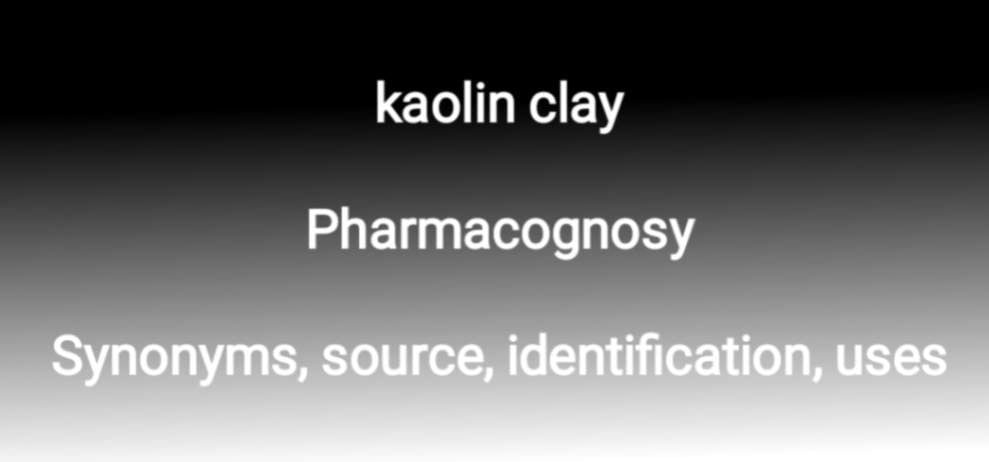Kaolin Pharmacognosy 1| Kaolin clay Synonyms, Uses hello friends welcome to our website here we are going to discuss about Kaolin as a pharmaceutical aid. Let us see in detail about Synonyms, source, Geographical source, description, standards, Solubility, identification, uses.
Kaolin

Kaolin clay
Synonyms are China clay, kaolinum proderesum, porcelain clay are the different names in different regions.
Kaolin is a purified native hydrated aluminium silicate approximately H2Al2Si2O8. H2O free from gritty or sandy particles. It is obtained by powdering the native kaolin, elutriating and collecting the fraction, which complies with the requirement of particle size. The native clay is derived from Decomposition of the feldspar (Potassium aluminosilicate) or granite rock and contains silica 47%,alumina 40 %, and water 13%.
Follow us on link
Kaolin is chemically classified as
Kaolin is classified in three types which are given as :
Source of kaolin mainly found in South Eastern United States, England, France and India.
The different types of kaolin are as follows :
- Heavy kaolin : it is purified hydrated aluminium silicate powdered so as to make free from gritty particles by elutriation.
- Light kaolin : it is identical with heavy kaolin, but is limited to certain particle size and contains suitable dispersing agent.
- Natural light kaolin : It is also a native hydrated aluminium silicate free from gritty particles, but it does not contain dispersing agent.
Kaolin chemical composition
Chemical composition is made up of certain percentage of minerals together given below are the constituents kaolin are made of.
Colour : It is white, but often gets tinged to grey, yellow or brown due to impurities.
Odour : it is almost odourless
Size : 10 micron to 690 micron in size.
Standards :
Fusion point : 1700° to 1800°C
Density : 2.3
Solubility :
It is iinsoluble in water and in mineral acids. It is not affected by dilute hydrochloric acid, but decomposed by concentrated sulphuric acid after prolonged boiling. It absorbs small amount of water which is hygroscopic in nature.solubility of kaolin are as follows.
Identification test
- Heat the kaolin on charcoal block with cobalt nitrate, it results in a blue mass due to alumina.
- Fuse 11 g of kaolin with 2g anhydrous sodium carbonate, warm water and filter. Acidify the filtrate with hydrochloric acid, dilute and water warm. Residue of silica is obtained, the solutions after neutralisation gives reactions characteristics to aluminium.we confirms the kaolin.
Kaolin uses
It is used as an adsorbent ( surface phenomenon) by oral administration, in the treatment of enteritis, colitis, dysentery and in alkaloidal and food poisoning. It is also applied externally as dusting powder and also as clarifying agent during the filtration. Mostly light kaolin with a particle size less than 10 micron is used in pharmaceutical preparations.
It is used as an ingredient of toilet powder and a base of disinfectant powders.
Heavy kaolin with particle size upto 60 micron is only used in the preparation of kaolin poultice.
It iis used as filter in paper, rubber, refractory, ceramics, cement and fertilizers industries. It is used in anticaking preparation, cosmetic, insecticide, paints and as source of alumina.
Iight kaolin is used as dusting powder.
You can also read:
Dioscorea Pharmacognosy 2023 | Dioscorea deltoidea Synonyms, uses
Conclusion
So friends this was all about kKaolin clay and its types. We see how the heavy, light and natural light kaolin are used. The kaolin we used is a pharmaceutical aid which has many applications like we used as dusting powder, clarifying agent, Pharmaceutical preparation, disinfectant powder. This was all about the kaolin powder. I hope you get a clear understanding of the topic. If you like this article please tell us in comment section. If you see we miss important topic comment below we will try to cover it. Thank you. Visit our website next time.










